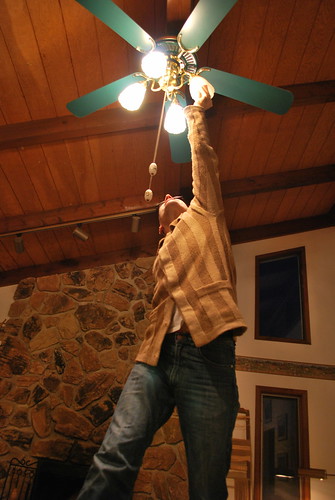
{Photo by rocketlass.}
Over the weekend I read Steven Johnson's The Invention of Air (2008), a brief biography of eighteenth-century English scientist and thinker Joseph Priestley. While neither as compelling nor as surprising in its association of unexpected ideas as Johnson's excellent The Ghost Map, The Invention of Air is lively and fun nonetheless, offering a cast full of the sort of endlessly interesting polymaths in which the late eighteenth century abounds, including Benjamin Franklin, Thomas Jefferson, John Adams, the Lunar Men, and even, briefly, Samuel Johnson and Edmund Burke.
The scene that stuck in my mind, however, was an account early of a demonstration by an "electrician," as both scientists and performers working with electricity were then known. Priestley was an early devotee of the study of electricity, and Johnson describes an electrical performance to give a sense of the sensationalized public face of the science at that time:
In this case, a young boy suspended in the air with silk ropes is positively charged by a machine that generates static electricity. First the boy's hair spikes up. Then, as the onlookers gasp in amazement, he reaches to touch a small girl, and sparks shoot between their fingertips. Willing volunteers were regularly pulled out of the audience to experience the voltage firsthand.That scene reminded me of one from my own childhood. Once or twice each year one of my middle school science teachers, Mr. Elliott, would climb up into the junk-laden attic space above his classroom and emerge with an old hand-cranked electrical generator that he'd built around the time Ben Franklin was tying the key to the tail of his kite. Ordering the students to join hands in a circle around his desk, he would hand one alligator clip to the student on his left and one to the student on his right, then demonstrate the workings of electricity by cranking the generator with all the mania of a character out of Melville. The shock would start slowly--a tiny, even ticklish twinge--then build and build alongside the whining of the machine until it became distinctly uncomfortable and, despite our brave fronts, we began casting our eyes around the circle, wondering who would have the guts to save us by dropping their hands.
Eventually someone would do just that, to a gasp of inarticulate appreciation from the class. Then Mr. Elliott--old, leathery, smelling of tobacco and either whiskey or aftershave--would laugh. His was not, as I remember it now, a malicious laugh, but almost a companionable one, suggesting something along the lines of "We're all in this together"--though of course as Mr. Elliott had one hand busily cranking the generator and the other pressed to its wooden base, both well out of the human circuit he'd created, that was far from the case.
Being middle school students, we didn't complain; this was just one more semi-inscrutable behavior on the part of the generally inscrutable adults in our lives, little different in kind from the various punishments that awaited us every day in gym. In fact, on a couple of different occasions when the generator was on display and Mr. Elliott made the mistake of leaving the room, some of the more adventurous students took turns seeing how much current they could stand all by themselves. Few clandestine classroom activities were ever more gripping.
No comments:
Post a Comment